Policy, Power and Politics in Health Care Provision
VerifiedAdded on 2023/01/12
|9
|2321
|1
AI Summary
This document discusses the policy cycle in health care provision, types of health policy documents, the concept of new public health, sociological issues affecting health, and factors to consider when creating a smoke-free environment policy.
Contribute Materials
Your contribution can guide someone’s learning journey. Share your
documents today.
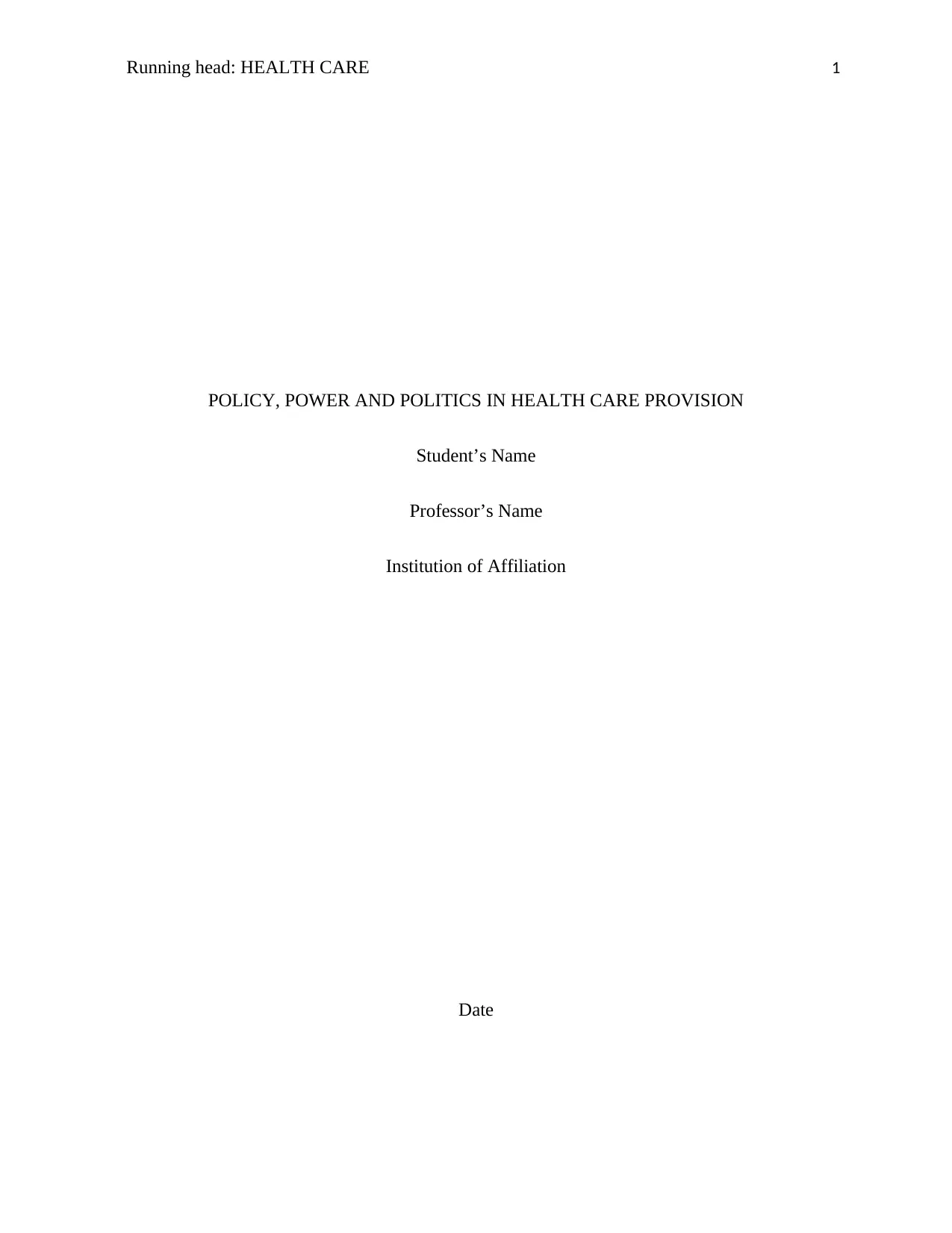
Running head: HEALTH CARE 1
POLICY, POWER AND POLITICS IN HEALTH CARE PROVISION
Student’s Name
Professor’s Name
Institution of Affiliation
Date
POLICY, POWER AND POLITICS IN HEALTH CARE PROVISION
Student’s Name
Professor’s Name
Institution of Affiliation
Date
Secure Best Marks with AI Grader
Need help grading? Try our AI Grader for instant feedback on your assignments.

HEALTH CARE 2
Question one answer.
A Policy cycle assists in the splitting of the policymaking process into various stages so
that an excellent policy developed. The cycle bears six important stages starting with agenda
setting, policy formulation, legitimation, implementation, evaluation and lastly, policy
maintenance, succession, and termination. Each of the stages plays a crucial part in assuring
proper decision making and development of the best new policy (Janssen, & Helbig, 2018).
Agenda setting stage focuses on identification of the problems that require attention,
deciding the matters that deserve much attention and describing the nature of the difficulty.
Policy formulation is the second stage which aids in setting aims, revealing the cost and
appropriating the result of solutions — additionally, selection of the best solutions from the
highlighted ones as well as choosing policy instrument (Camagni, & Capello, 2017).
Legitimation being the third stage of policy cycle entails ensuring proper support of the
selected policy instrument — several approvals by executives, legislative or seeking accord via
consultation with the group involved and referenda. Policy legitimation is vital since it legalizes
the policy to implement sooner. Implementation is the fourth stage in the policy cycle that
involves assigning a group of people to take responsibility for implementing policy by ensuring
that all the necessary equipment, resources, and facilities are available.
Evaluation stage is very vital since it analyses the success of the policy made in terms of
desired outcome, correct implementation and decision making. The last stage entails making
considerations as whether to continue, modify or discontinue the policy. Hence, the policy cycle
is useful, simple and easily understood to assist in making the best policy. Policy cycle the best
Question one answer.
A Policy cycle assists in the splitting of the policymaking process into various stages so
that an excellent policy developed. The cycle bears six important stages starting with agenda
setting, policy formulation, legitimation, implementation, evaluation and lastly, policy
maintenance, succession, and termination. Each of the stages plays a crucial part in assuring
proper decision making and development of the best new policy (Janssen, & Helbig, 2018).
Agenda setting stage focuses on identification of the problems that require attention,
deciding the matters that deserve much attention and describing the nature of the difficulty.
Policy formulation is the second stage which aids in setting aims, revealing the cost and
appropriating the result of solutions — additionally, selection of the best solutions from the
highlighted ones as well as choosing policy instrument (Camagni, & Capello, 2017).
Legitimation being the third stage of policy cycle entails ensuring proper support of the
selected policy instrument — several approvals by executives, legislative or seeking accord via
consultation with the group involved and referenda. Policy legitimation is vital since it legalizes
the policy to implement sooner. Implementation is the fourth stage in the policy cycle that
involves assigning a group of people to take responsibility for implementing policy by ensuring
that all the necessary equipment, resources, and facilities are available.
Evaluation stage is very vital since it analyses the success of the policy made in terms of
desired outcome, correct implementation and decision making. The last stage entails making
considerations as whether to continue, modify or discontinue the policy. Hence, the policy cycle
is useful, simple and easily understood to assist in making the best policy. Policy cycle the best
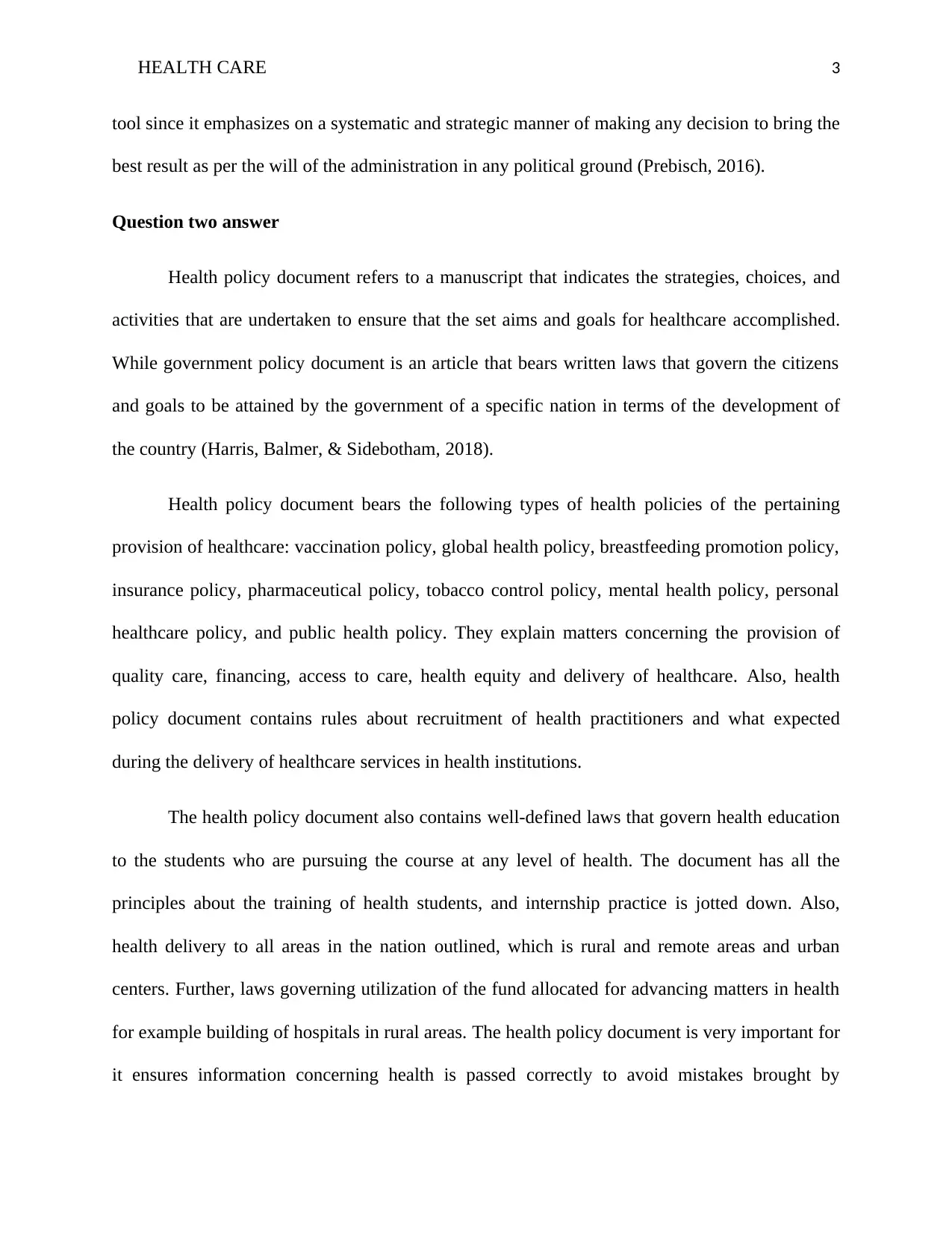
HEALTH CARE 3
tool since it emphasizes on a systematic and strategic manner of making any decision to bring the
best result as per the will of the administration in any political ground (Prebisch, 2016).
Question two answer
Health policy document refers to a manuscript that indicates the strategies, choices, and
activities that are undertaken to ensure that the set aims and goals for healthcare accomplished.
While government policy document is an article that bears written laws that govern the citizens
and goals to be attained by the government of a specific nation in terms of the development of
the country (Harris, Balmer, & Sidebotham, 2018).
Health policy document bears the following types of health policies of the pertaining
provision of healthcare: vaccination policy, global health policy, breastfeeding promotion policy,
insurance policy, pharmaceutical policy, tobacco control policy, mental health policy, personal
healthcare policy, and public health policy. They explain matters concerning the provision of
quality care, financing, access to care, health equity and delivery of healthcare. Also, health
policy document contains rules about recruitment of health practitioners and what expected
during the delivery of healthcare services in health institutions.
The health policy document also contains well-defined laws that govern health education
to the students who are pursuing the course at any level of health. The document has all the
principles about the training of health students, and internship practice is jotted down. Also,
health delivery to all areas in the nation outlined, which is rural and remote areas and urban
centers. Further, laws governing utilization of the fund allocated for advancing matters in health
for example building of hospitals in rural areas. The health policy document is very important for
it ensures information concerning health is passed correctly to avoid mistakes brought by
tool since it emphasizes on a systematic and strategic manner of making any decision to bring the
best result as per the will of the administration in any political ground (Prebisch, 2016).
Question two answer
Health policy document refers to a manuscript that indicates the strategies, choices, and
activities that are undertaken to ensure that the set aims and goals for healthcare accomplished.
While government policy document is an article that bears written laws that govern the citizens
and goals to be attained by the government of a specific nation in terms of the development of
the country (Harris, Balmer, & Sidebotham, 2018).
Health policy document bears the following types of health policies of the pertaining
provision of healthcare: vaccination policy, global health policy, breastfeeding promotion policy,
insurance policy, pharmaceutical policy, tobacco control policy, mental health policy, personal
healthcare policy, and public health policy. They explain matters concerning the provision of
quality care, financing, access to care, health equity and delivery of healthcare. Also, health
policy document contains rules about recruitment of health practitioners and what expected
during the delivery of healthcare services in health institutions.
The health policy document also contains well-defined laws that govern health education
to the students who are pursuing the course at any level of health. The document has all the
principles about the training of health students, and internship practice is jotted down. Also,
health delivery to all areas in the nation outlined, which is rural and remote areas and urban
centers. Further, laws governing utilization of the fund allocated for advancing matters in health
for example building of hospitals in rural areas. The health policy document is very important for
it ensures information concerning health is passed correctly to avoid mistakes brought by
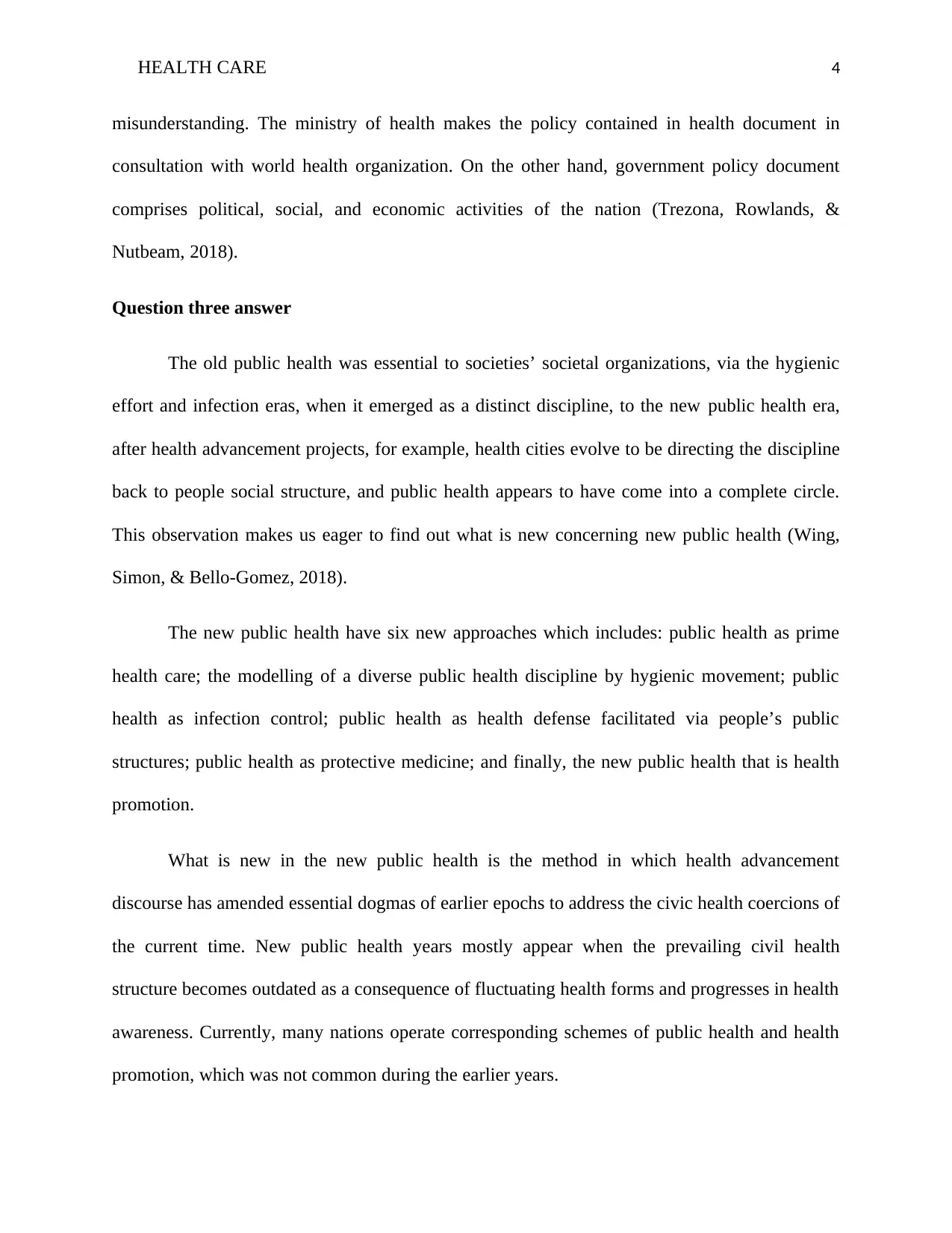
HEALTH CARE 4
misunderstanding. The ministry of health makes the policy contained in health document in
consultation with world health organization. On the other hand, government policy document
comprises political, social, and economic activities of the nation (Trezona, Rowlands, &
Nutbeam, 2018).
Question three answer
The old public health was essential to societies’ societal organizations, via the hygienic
effort and infection eras, when it emerged as a distinct discipline, to the new public health era,
after health advancement projects, for example, health cities evolve to be directing the discipline
back to people social structure, and public health appears to have come into a complete circle.
This observation makes us eager to find out what is new concerning new public health (Wing,
Simon, & Bello-Gomez, 2018).
The new public health have six new approaches which includes: public health as prime
health care; the modelling of a diverse public health discipline by hygienic movement; public
health as infection control; public health as health defense facilitated via people’s public
structures; public health as protective medicine; and finally, the new public health that is health
promotion.
What is new in the new public health is the method in which health advancement
discourse has amended essential dogmas of earlier epochs to address the civic health coercions of
the current time. New public health years mostly appear when the prevailing civil health
structure becomes outdated as a consequence of fluctuating health forms and progresses in health
awareness. Currently, many nations operate corresponding schemes of public health and health
promotion, which was not common during the earlier years.
misunderstanding. The ministry of health makes the policy contained in health document in
consultation with world health organization. On the other hand, government policy document
comprises political, social, and economic activities of the nation (Trezona, Rowlands, &
Nutbeam, 2018).
Question three answer
The old public health was essential to societies’ societal organizations, via the hygienic
effort and infection eras, when it emerged as a distinct discipline, to the new public health era,
after health advancement projects, for example, health cities evolve to be directing the discipline
back to people social structure, and public health appears to have come into a complete circle.
This observation makes us eager to find out what is new concerning new public health (Wing,
Simon, & Bello-Gomez, 2018).
The new public health have six new approaches which includes: public health as prime
health care; the modelling of a diverse public health discipline by hygienic movement; public
health as infection control; public health as health defense facilitated via people’s public
structures; public health as protective medicine; and finally, the new public health that is health
promotion.
What is new in the new public health is the method in which health advancement
discourse has amended essential dogmas of earlier epochs to address the civic health coercions of
the current time. New public health years mostly appear when the prevailing civil health
structure becomes outdated as a consequence of fluctuating health forms and progresses in health
awareness. Currently, many nations operate corresponding schemes of public health and health
promotion, which was not common during the earlier years.
Secure Best Marks with AI Grader
Need help grading? Try our AI Grader for instant feedback on your assignments.
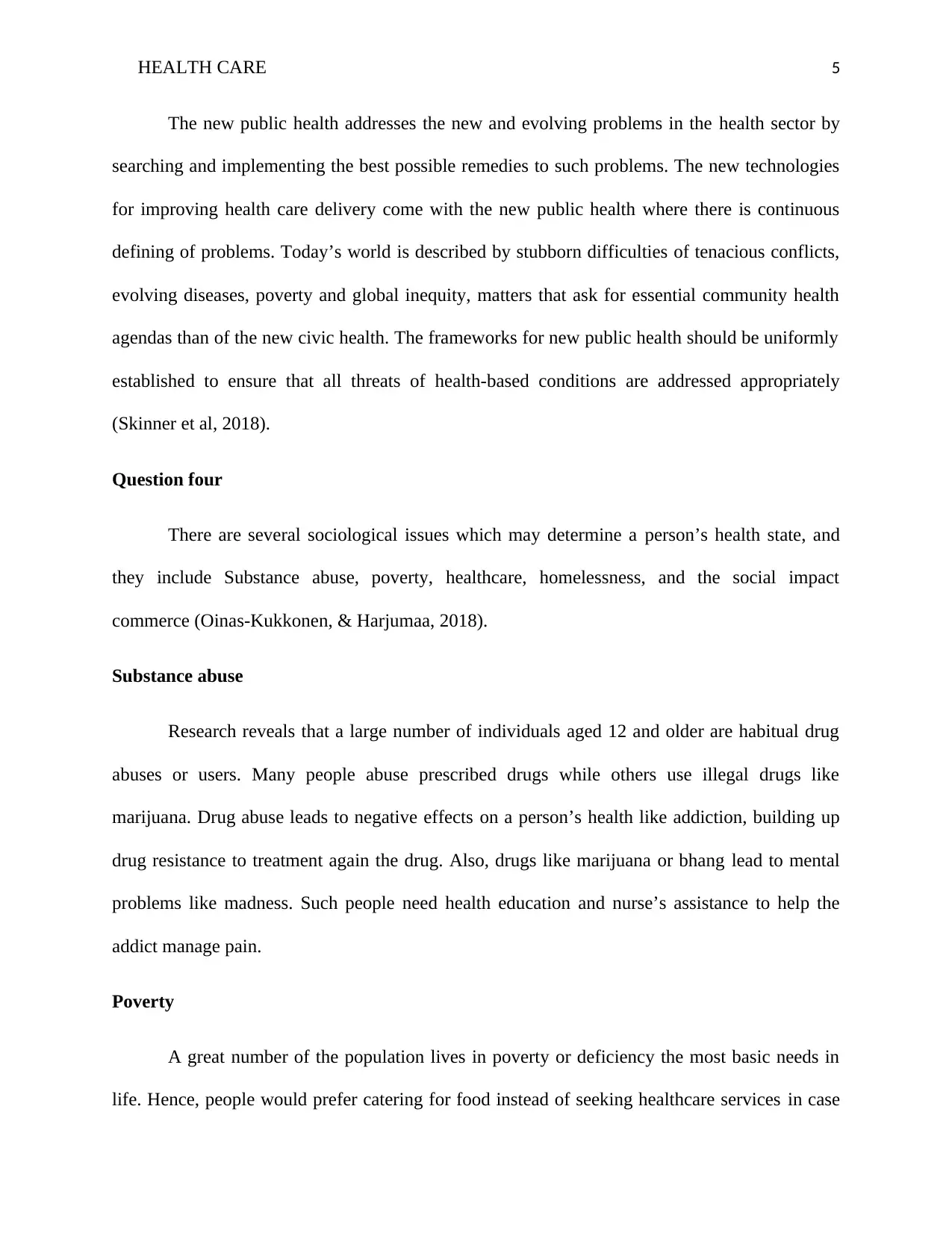
HEALTH CARE 5
The new public health addresses the new and evolving problems in the health sector by
searching and implementing the best possible remedies to such problems. The new technologies
for improving health care delivery come with the new public health where there is continuous
defining of problems. Today’s world is described by stubborn difficulties of tenacious conflicts,
evolving diseases, poverty and global inequity, matters that ask for essential community health
agendas than of the new civic health. The frameworks for new public health should be uniformly
established to ensure that all threats of health-based conditions are addressed appropriately
(Skinner et al, 2018).
Question four
There are several sociological issues which may determine a person’s health state, and
they include Substance abuse, poverty, healthcare, homelessness, and the social impact
commerce (Oinas-Kukkonen, & Harjumaa, 2018).
Substance abuse
Research reveals that a large number of individuals aged 12 and older are habitual drug
abuses or users. Many people abuse prescribed drugs while others use illegal drugs like
marijuana. Drug abuse leads to negative effects on a person’s health like addiction, building up
drug resistance to treatment again the drug. Also, drugs like marijuana or bhang lead to mental
problems like madness. Such people need health education and nurse’s assistance to help the
addict manage pain.
Poverty
A great number of the population lives in poverty or deficiency the most basic needs in
life. Hence, people would prefer catering for food instead of seeking healthcare services in case
The new public health addresses the new and evolving problems in the health sector by
searching and implementing the best possible remedies to such problems. The new technologies
for improving health care delivery come with the new public health where there is continuous
defining of problems. Today’s world is described by stubborn difficulties of tenacious conflicts,
evolving diseases, poverty and global inequity, matters that ask for essential community health
agendas than of the new civic health. The frameworks for new public health should be uniformly
established to ensure that all threats of health-based conditions are addressed appropriately
(Skinner et al, 2018).
Question four
There are several sociological issues which may determine a person’s health state, and
they include Substance abuse, poverty, healthcare, homelessness, and the social impact
commerce (Oinas-Kukkonen, & Harjumaa, 2018).
Substance abuse
Research reveals that a large number of individuals aged 12 and older are habitual drug
abuses or users. Many people abuse prescribed drugs while others use illegal drugs like
marijuana. Drug abuse leads to negative effects on a person’s health like addiction, building up
drug resistance to treatment again the drug. Also, drugs like marijuana or bhang lead to mental
problems like madness. Such people need health education and nurse’s assistance to help the
addict manage pain.
Poverty
A great number of the population lives in poverty or deficiency the most basic needs in
life. Hence, people would prefer catering for food instead of seeking healthcare services in case
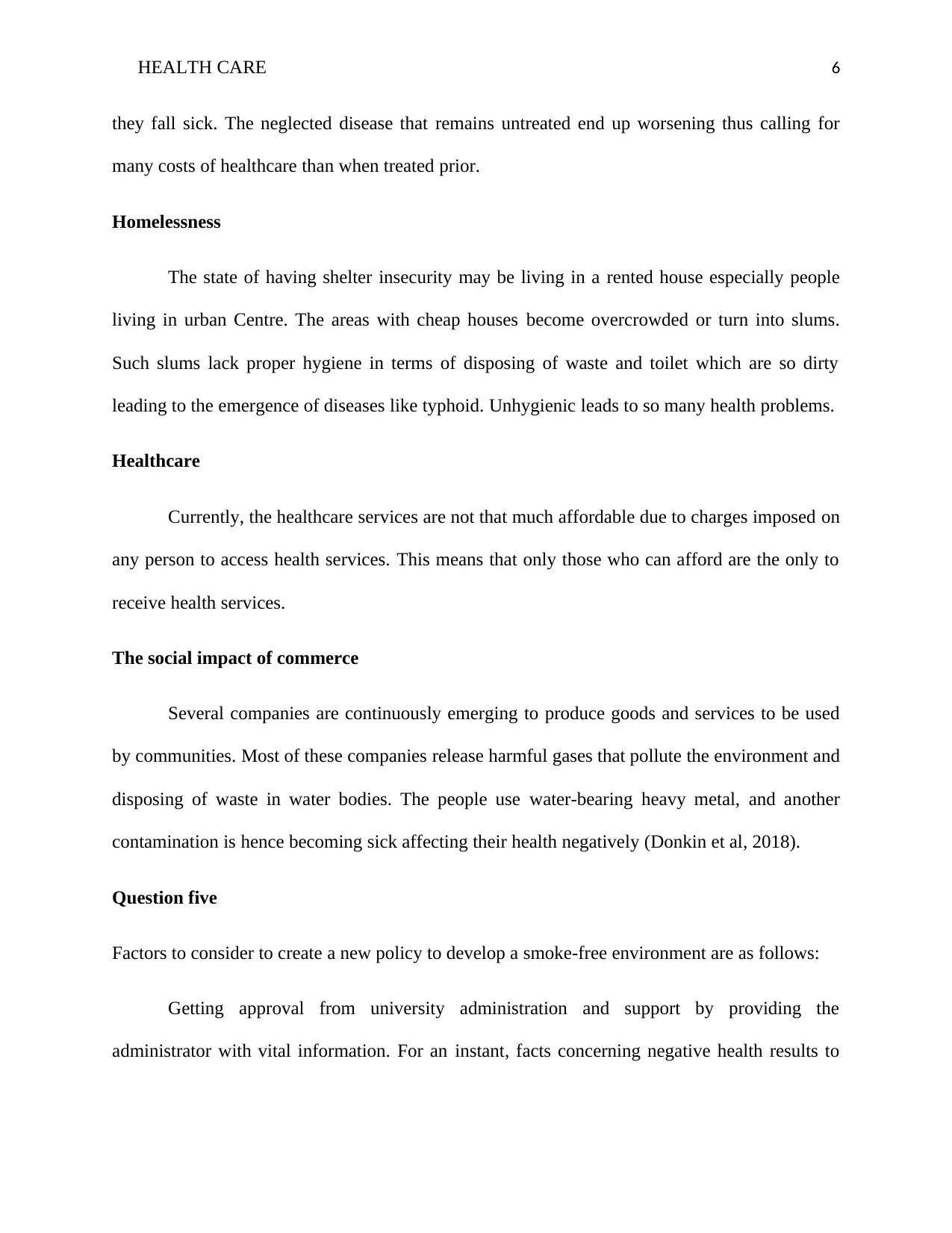
HEALTH CARE 6
they fall sick. The neglected disease that remains untreated end up worsening thus calling for
many costs of healthcare than when treated prior.
Homelessness
The state of having shelter insecurity may be living in a rented house especially people
living in urban Centre. The areas with cheap houses become overcrowded or turn into slums.
Such slums lack proper hygiene in terms of disposing of waste and toilet which are so dirty
leading to the emergence of diseases like typhoid. Unhygienic leads to so many health problems.
Healthcare
Currently, the healthcare services are not that much affordable due to charges imposed on
any person to access health services. This means that only those who can afford are the only to
receive health services.
The social impact of commerce
Several companies are continuously emerging to produce goods and services to be used
by communities. Most of these companies release harmful gases that pollute the environment and
disposing of waste in water bodies. The people use water-bearing heavy metal, and another
contamination is hence becoming sick affecting their health negatively (Donkin et al, 2018).
Question five
Factors to consider to create a new policy to develop a smoke-free environment are as follows:
Getting approval from university administration and support by providing the
administrator with vital information. For an instant, facts concerning negative health results to
they fall sick. The neglected disease that remains untreated end up worsening thus calling for
many costs of healthcare than when treated prior.
Homelessness
The state of having shelter insecurity may be living in a rented house especially people
living in urban Centre. The areas with cheap houses become overcrowded or turn into slums.
Such slums lack proper hygiene in terms of disposing of waste and toilet which are so dirty
leading to the emergence of diseases like typhoid. Unhygienic leads to so many health problems.
Healthcare
Currently, the healthcare services are not that much affordable due to charges imposed on
any person to access health services. This means that only those who can afford are the only to
receive health services.
The social impact of commerce
Several companies are continuously emerging to produce goods and services to be used
by communities. Most of these companies release harmful gases that pollute the environment and
disposing of waste in water bodies. The people use water-bearing heavy metal, and another
contamination is hence becoming sick affecting their health negatively (Donkin et al, 2018).
Question five
Factors to consider to create a new policy to develop a smoke-free environment are as follows:
Getting approval from university administration and support by providing the
administrator with vital information. For an instant, facts concerning negative health results to

HEALTH CARE 7
the environment due to tobacco smoke. Also, explaining the overall importance of implementing
a smoke-free learning premise or institution (Ryder, Couch, & Chaffee, 2018).
The second factor is to find out the existing activities already in the university like a
business selling tobacco product. Knowledge of existing activities will aid knowing who will be
affected by the policy and find out how to deal with — the number of already smoking people
within the university determined by interviewing the tobacco business people.
Thirdly, is determining the person or person (s) to enforce the policy. Consider coming
up with a committee like occupational health and safety committee of the university in the
faculty of health science. Also, appointing of some of the staff like the professor who will
supervise and manage the enactment process (Munson, Barabasz, & Barabasz, 2018).
Provision of education based on the policy earlier to the enactment of the policy. Training
conferences organized for the university students’, the teaching staff and nonteaching staff at
different places. The training aims to inform them of the various negative effect of tobacco
smoke environment. The university people should be aware of: the date for the enactment of the
policy, the accountability of the students’ and staffs to politely approach visitors who may tend
to smoke at the university (Kiyohara, & Tabuchi, 2018).
Preparation of the university for implantation of the policy which can be done by
displaying posters bearing the implementation date. Also, erecting burners and posters with no
smoking signage and excellently noticing the border of designating smoking areas in the
university appropriately.
the environment due to tobacco smoke. Also, explaining the overall importance of implementing
a smoke-free learning premise or institution (Ryder, Couch, & Chaffee, 2018).
The second factor is to find out the existing activities already in the university like a
business selling tobacco product. Knowledge of existing activities will aid knowing who will be
affected by the policy and find out how to deal with — the number of already smoking people
within the university determined by interviewing the tobacco business people.
Thirdly, is determining the person or person (s) to enforce the policy. Consider coming
up with a committee like occupational health and safety committee of the university in the
faculty of health science. Also, appointing of some of the staff like the professor who will
supervise and manage the enactment process (Munson, Barabasz, & Barabasz, 2018).
Provision of education based on the policy earlier to the enactment of the policy. Training
conferences organized for the university students’, the teaching staff and nonteaching staff at
different places. The training aims to inform them of the various negative effect of tobacco
smoke environment. The university people should be aware of: the date for the enactment of the
policy, the accountability of the students’ and staffs to politely approach visitors who may tend
to smoke at the university (Kiyohara, & Tabuchi, 2018).
Preparation of the university for implantation of the policy which can be done by
displaying posters bearing the implementation date. Also, erecting burners and posters with no
smoking signage and excellently noticing the border of designating smoking areas in the
university appropriately.
Paraphrase This Document
Need a fresh take? Get an instant paraphrase of this document with our AI Paraphraser
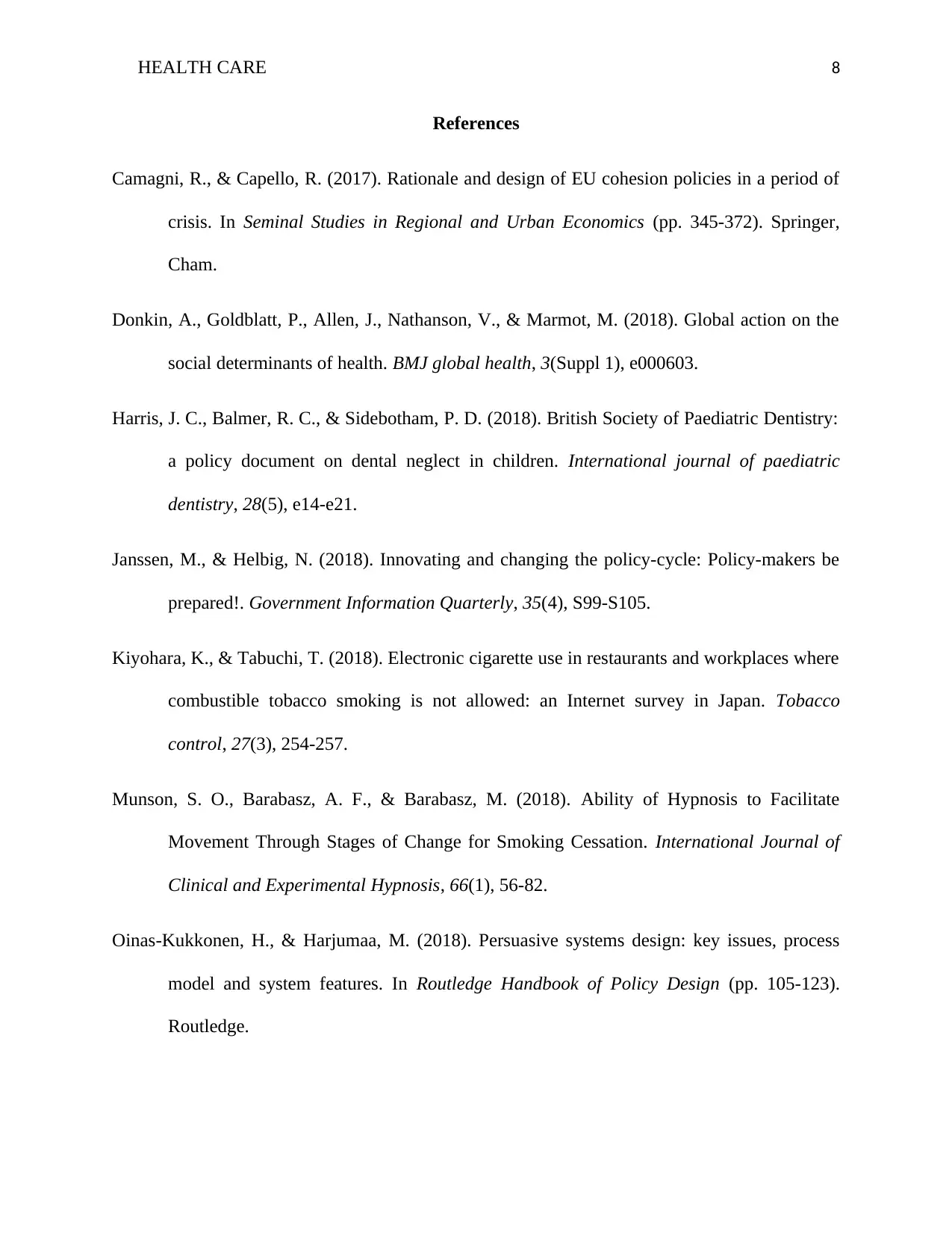
HEALTH CARE 8
References
Camagni, R., & Capello, R. (2017). Rationale and design of EU cohesion policies in a period of
crisis. In Seminal Studies in Regional and Urban Economics (pp. 345-372). Springer,
Cham.
Donkin, A., Goldblatt, P., Allen, J., Nathanson, V., & Marmot, M. (2018). Global action on the
social determinants of health. BMJ global health, 3(Suppl 1), e000603.
Harris, J. C., Balmer, R. C., & Sidebotham, P. D. (2018). British Society of Paediatric Dentistry:
a policy document on dental neglect in children. International journal of paediatric
dentistry, 28(5), e14-e21.
Janssen, M., & Helbig, N. (2018). Innovating and changing the policy-cycle: Policy-makers be
prepared!. Government Information Quarterly, 35(4), S99-S105.
Kiyohara, K., & Tabuchi, T. (2018). Electronic cigarette use in restaurants and workplaces where
combustible tobacco smoking is not allowed: an Internet survey in Japan. Tobacco
control, 27(3), 254-257.
Munson, S. O., Barabasz, A. F., & Barabasz, M. (2018). Ability of Hypnosis to Facilitate
Movement Through Stages of Change for Smoking Cessation. International Journal of
Clinical and Experimental Hypnosis, 66(1), 56-82.
Oinas-Kukkonen, H., & Harjumaa, M. (2018). Persuasive systems design: key issues, process
model and system features. In Routledge Handbook of Policy Design (pp. 105-123).
Routledge.
References
Camagni, R., & Capello, R. (2017). Rationale and design of EU cohesion policies in a period of
crisis. In Seminal Studies in Regional and Urban Economics (pp. 345-372). Springer,
Cham.
Donkin, A., Goldblatt, P., Allen, J., Nathanson, V., & Marmot, M. (2018). Global action on the
social determinants of health. BMJ global health, 3(Suppl 1), e000603.
Harris, J. C., Balmer, R. C., & Sidebotham, P. D. (2018). British Society of Paediatric Dentistry:
a policy document on dental neglect in children. International journal of paediatric
dentistry, 28(5), e14-e21.
Janssen, M., & Helbig, N. (2018). Innovating and changing the policy-cycle: Policy-makers be
prepared!. Government Information Quarterly, 35(4), S99-S105.
Kiyohara, K., & Tabuchi, T. (2018). Electronic cigarette use in restaurants and workplaces where
combustible tobacco smoking is not allowed: an Internet survey in Japan. Tobacco
control, 27(3), 254-257.
Munson, S. O., Barabasz, A. F., & Barabasz, M. (2018). Ability of Hypnosis to Facilitate
Movement Through Stages of Change for Smoking Cessation. International Journal of
Clinical and Experimental Hypnosis, 66(1), 56-82.
Oinas-Kukkonen, H., & Harjumaa, M. (2018). Persuasive systems design: key issues, process
model and system features. In Routledge Handbook of Policy Design (pp. 105-123).
Routledge.
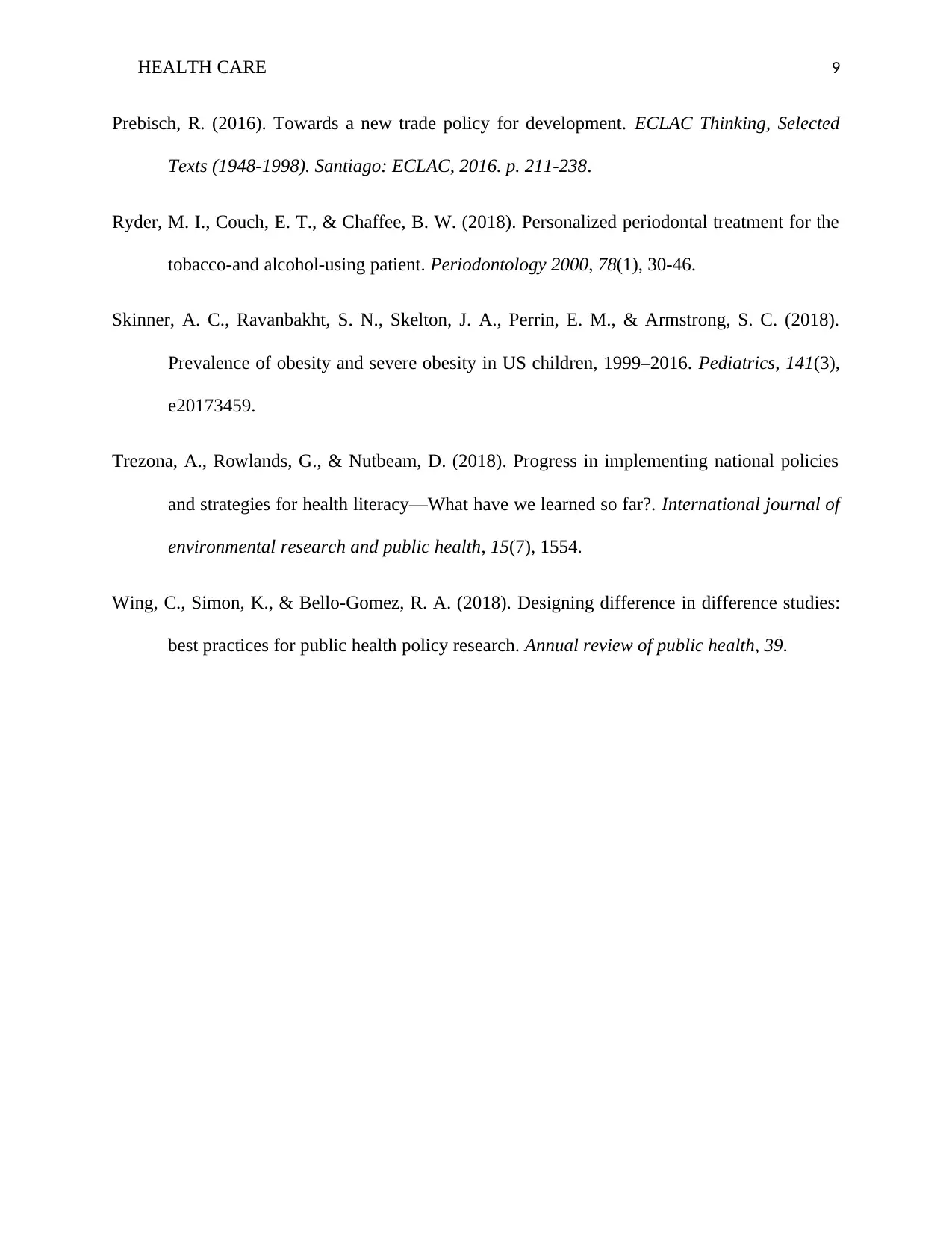
HEALTH CARE 9
Prebisch, R. (2016). Towards a new trade policy for development. ECLAC Thinking, Selected
Texts (1948-1998). Santiago: ECLAC, 2016. p. 211-238.
Ryder, M. I., Couch, E. T., & Chaffee, B. W. (2018). Personalized periodontal treatment for the
tobacco‐and alcohol‐using patient. Periodontology 2000, 78(1), 30-46.
Skinner, A. C., Ravanbakht, S. N., Skelton, J. A., Perrin, E. M., & Armstrong, S. C. (2018).
Prevalence of obesity and severe obesity in US children, 1999–2016. Pediatrics, 141(3),
e20173459.
Trezona, A., Rowlands, G., & Nutbeam, D. (2018). Progress in implementing national policies
and strategies for health literacy—What have we learned so far?. International journal of
environmental research and public health, 15(7), 1554.
Wing, C., Simon, K., & Bello-Gomez, R. A. (2018). Designing difference in difference studies:
best practices for public health policy research. Annual review of public health, 39.
Prebisch, R. (2016). Towards a new trade policy for development. ECLAC Thinking, Selected
Texts (1948-1998). Santiago: ECLAC, 2016. p. 211-238.
Ryder, M. I., Couch, E. T., & Chaffee, B. W. (2018). Personalized periodontal treatment for the
tobacco‐and alcohol‐using patient. Periodontology 2000, 78(1), 30-46.
Skinner, A. C., Ravanbakht, S. N., Skelton, J. A., Perrin, E. M., & Armstrong, S. C. (2018).
Prevalence of obesity and severe obesity in US children, 1999–2016. Pediatrics, 141(3),
e20173459.
Trezona, A., Rowlands, G., & Nutbeam, D. (2018). Progress in implementing national policies
and strategies for health literacy—What have we learned so far?. International journal of
environmental research and public health, 15(7), 1554.
Wing, C., Simon, K., & Bello-Gomez, R. A. (2018). Designing difference in difference studies:
best practices for public health policy research. Annual review of public health, 39.
1 out of 9
Related Documents
Your All-in-One AI-Powered Toolkit for Academic Success.
+13062052269
info@desklib.com
Available 24*7 on WhatsApp / Email
![[object Object]](/_next/static/media/star-bottom.7253800d.svg)
Unlock your academic potential
© 2024 | Zucol Services PVT LTD | All rights reserved.




